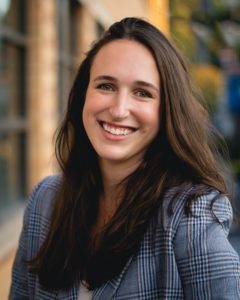Over the past three years, Betsy Naymon has played a vital role at Building Changes as Senior Research Associate, helping to connect data and research with the lived experiences of students and families experiencing homelessness. As she embarks on her next adventure, graduate studies at the London School of Economics and Political Science, she reflects on what she has learned, the stories that stayed with her, and her hopes for the future of housing and education in Washington State.
Q: Please tell me about your next adventure!

Betsy Naymon, former Senior Research Associate
I’m moving to London to attend the London School of Economics and Political Science. The idea grew out of my time at Building Changes, where I worked with large datasets and realized how powerful they can be in telling stories about people’s lives. I wanted to learn more advanced techniques so I can answer complex questions with confidence. For example, after releasing our Students Experiencing Homelessness in Washington’s K–12 Public Schools: 2016-2023 Trends, Characteristics, and Academic Outcomes report, I was asked, “At the current pace, when will graduation rates between housed and homeless students be equal?” I wasn’t sure how to answer, but I want to gain the skills to!
Q: Can you share about your role at Building Changes?
As Senior Research Associate, I split my time between education and housing. On one side, I worked on projects like the above K-12 Report and the School/Housing Network. On the other, I focused on the Homeless Student Stability Program (HSSP). I loved that balance. It let me think big about systems while also working closely with agencies on real-world challenges.
Q: How do data and evaluation connect to individual stories? Is there one that stayed with you?
To me, data is just a collection of individual stories woven together. Research is a way of keeping a record of human experience. Without it, the struggles of children and families experiencing homelessness can be overlooked.
One story that really stayed with me came from a Washington Youth & Families Fund grantee, Abused Deaf Women’s Advocacy Services (ADWAS). They offered ASL classes for children of deaf adults. Parents told us how meaningful it was to finally ask their kids about homework or a school trip and truly understand the answer. That story struck me because it showed how important everyday connection is, especially for families already navigating the stress of housing instability.
Q: In your three years here, how has the work grown?
It has been exciting to watch the education work grow. When I started, the ABC tool was just beginning. By the third round, participants were praising it and asking for more. Our School/Housing Network has expanded to bring together school staff from across the state. HSSP has also grown—when I began, we supported four grantees, and now it’s more than a dozen. The program feels much more intentional, and our partnerships with government agencies have deepened. I hope this continues. I also hope the voices of HSSP grantees are even more woven into the program, so they can help shape it with their expertise.
Q: What are some strategies that are helping address homelessness?
More and more, people involved in this work are recognizing that housing is holistic. Stability often depends on small but critical supports, like covering a car repair or medical bill that could otherwise put a family at risk of losing their home. That’s why HSSP is so valuable— it’s one of the only government programs that can provide housing assistance to people who are not literally homeless. It helps families stay housed before they reach crisis. Which is what we all want, right? I’m glad this idea is growing, like with the Youth Diversion Infrastructure Project work…it makes services more applicable to what people actually need. But, to answer your question, strategies that offer flexibility in how funds can be used to support people are really helping.
But the truth is, there just isn’t enough housing. We absolutely need more units, but also healthcare, good jobs, and other supports that help families build stability. My hope is that policymakers will continue to see housing as part of a bigger picture of wellbeing.
Q: What concerns you from a data perspective in today’s climate?
I worry about people’s safety, and about how data could be misused. Reports of data being shared with ICE have understandably created fear. Families may avoid services because they’re afraid of exposure, even if they desperately need help. That means their needs go unmet—and we also lose the ability to understand the true scope of homelessness. Without that data, we risk being blind to what’s happening in communities.
Q: What would you like to see Building Changes carry forward?
I hope we keep pushing for both data privacy and thoughtful data sharing. For example, regular access to K-12 student homelessness data would help us design services that respond directly to students’ experiences.
As a researcher, I feel a deep responsibility to honor the trust people place in us. Data is more than numbers—it’s evidence of people’s lives. Research is the written record of humanity, and it’s an honor to contribute to that.
